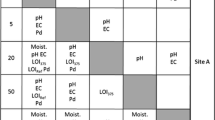Abstract
It is increasingly being recognised and environmental measurements have demonstrated that Platinum (Pt) (and potentially Rhodium (Rh) and Palladium (Pd)) is released with the ageing of catalytic converters. Platinum is a particular concern as it has a known mutagenic and toxic effect, even at exceedingly low concentrations, in urban air (affecting human health) and urban water (affecting ecosystem health). In the context given above and given the still keen lack of reliable experimental data on the levels of Pd, Pt and Rh in water and sediment, this study determined the concentration of such elements in water and sediment of the Pra estuary in the Western Region of Ghana where it is estimated that more than two thousand cars pass over the bridge under which the river flows to join the sea each day. Elevated concentrations of platinum (Pt), palladium (Pd) and Rhodium (Rh) were found to be associated with water and soils from areas of high traffic densities (Beposo) suggesting that vehicles also contribute heavy metals (PGMs) to the environment. The result showed elevated levels of these metals in river bank, waterbed and in the water. There is therefore the tendency of possible accumulation of these metals in plant and animals along these areas.
Similar content being viewed by others
References
Barbante, C., Veysseyre, A., Ferrari, C., Van de Velde, K., Morel, C., Capodaglio, G. et al. (2001). Greenland Snow evidence of large scale contamination for platinum, palladium, and rhodium. Environmental Science & Technology, 35, 835–839.
Barefoot, R. (1997). Determination of platinum at trace levels in environmental and biological materials. Environmental Science & Technology, 31, 309–313.
CORDIS (2003). Assessment of environmental contamination risk by platinum, rhodium and palladium from automobile catalyst. Environment and Climate. http://cordis.europa.eu/data/PROJ_ENV/ACTIONeqDndSESSIONeq27617200595ndDOCeq17ndTBLeqEN_PROJ.htm.
CPMP/SWP/QWP (2002). The European Agency for the evaluation of medicinal products. Evaluation of Medicines for Human use. London, 17 December 2002, CPMP/SWP/QWP/44446/00. Corrigendum to the version dated 26th June 2002.
Dominici, C., Petrucci, F., Caroli, S., Alimonti, A., Clerico, A., & Castello, M. (1989). A pharmacokinetic study of high dose continuous infusion cis-platin in children with solid tumors. Journal of Clinical Oncology, 7, 100.
EPA (2000). United States Environmental Protection Agency Washington, D.C. 20460. Office of Air and Radiation. http://www.epa.gov/otaq/cert/factshts/catcvrts.pdf.
Essumang, D. K., Dodoo, D. K., Obiri, S., & Oduro, B. A. K. (2006). Analysis of vehicular fallouts from traffic in the Kumasi metropolis. Bulletin of the Chemical Society of Ethiopia, 20(1), 9–15.
Ensslin, A. S., Pethran, A., Schierl, R., & Fruhmann, G. (1994). Urinary platinum in hospital personnel occupationally exposed to platinum-containing antineoplastic drugs. International Archives of Occupational and Environmental Health, 65, 339–342.
Helmers, E., Mergel, N., & Barchet, R. (1994). Platin in Klärschlammasche und an Gräsern UWSF-Z. Umweltchem. Ekotox, 6(3), 130–134.
Hodge, V. F., & Stallard, M. O. (1986). Platinum and palladium in roadside dust. Environmental Science & Technology, 20Ž, 1058.
Hoppe, R. (1965). Chemistry of the noble gases. Fortschritte der chemischen Forschung, 5, 213–346.
IPCS (International Programme on Chemical Safety) (1991). Environmental health criteria 125: platinum. Geneva, Switzerland: World Health Organization Press.
Känig, H. P., Hertel, R. F., Koch, W., & Rosner, G. (1992). Determination of platinum emissions from a three-way catalyst equipped gasoline engine. Atmospheric Environment A, 26, 741.
Lustig, S., Schierl, R., Alt, F., Helmers, E., & Kümmerer, K. (1997). Schwerpunktthema: platin in Umweltkompartimenten-Deposition, Verteilung sowie Bedeutung für den Munched und sein Nahrungsnetz. UWSF- Z. Umweltchem. Ökotox, 9, 149–152.
Nriagu, J. O. (1990). Heavy metal pollution poisoning the biosphere. Environment, 32(7), 7–11.
Nriagu, J. O., & Pacyna, J. M. (1988). Quantitative Assessment of world wide contamination of air, water and soil by trace metals. Nature, 333, 134–139.
Ranch, S., Motelica-Heino, M., Morrison, G., & Donard, F. (2000). Critical assessment of platinum group element determination in road and urban sediment using ultrasonic nubulization and high resolution ICP-MS. Journal of Analytical Atomic Spectrometry, 15, 329–334.
Rosner, G., & Merget, R. (1990). Allergenic potential of platinum compounds. In A. D. Dayan, R. F. Hertel, E. Heseltine, G. Kazantzis, E. M. Smith, & M. T. Van der Venne (Eds.) Immunotoxicity of metals and immunotoxicology (pp. 93–100). New York, London: Plenum.
Siva, S. N., Masuda, A., & Hirata, T. (1990). LA – ICP – Mass Analysis of Platinum in Environmental Soil Samples Following Micro – Fire Assay Technique in Symposium on Mass Spectrometry, 8th ISMAS, Hyderabad, India, Proceedings Volume, p. 535–537.
Tohs, S. J., & Bagchi, D. (1995). Oxidative mechanisms in the toxicity of metal ions. Free Radical Biology & Medicine, 18, 321–336.
Tolgyessy, J., & Kyrs, M. (1989). Radio analytical chemistry (Vols 1 and 2., pp. 1–354). Chichester: Ellis Horwood Ltd.
U.S. Commercial Service (2006). Your Global Business Partner http://www.buyusainfo.net
Vaughan, G. T., & Florence, T. M. (1992). Platinum in the human diet, blood, hair and excreta. Science of the Total Environment, 111, 47.
Ysart, G., et al. (1999). Dietary Exposure estimates of 30 elements in the UK Total Diet Study. Food Additives and Contaminants, 16(9), 391–403.
Author information
Authors and Affiliations
Corresponding author
Rights and permissions
About this article
Cite this article
Essumang, D.K., Dodoo, D.K. & Adokoh, C.K. The impact of vehicular fallout on the Pra estuary of Ghana (a case study of the impact of platinum group metals (PGMs) on the marine ecosystem). Environ Monit Assess 145, 283–294 (2008). https://doi.org/10.1007/s10661-007-0037-0
Received:
Accepted:
Published:
Issue Date:
DOI: https://doi.org/10.1007/s10661-007-0037-0




